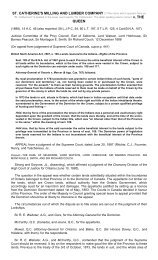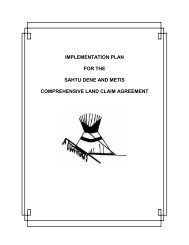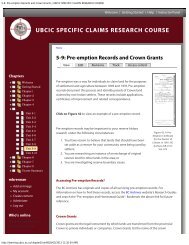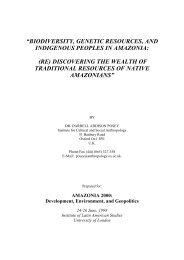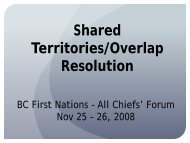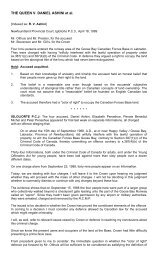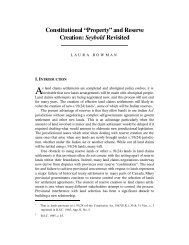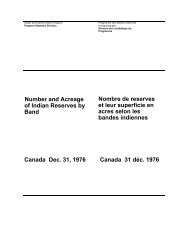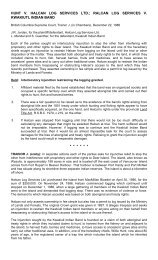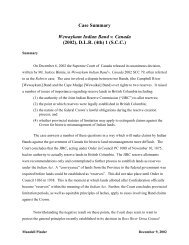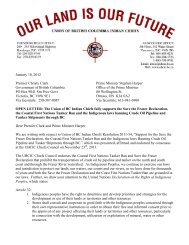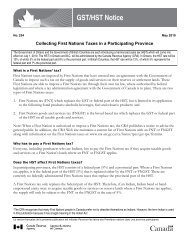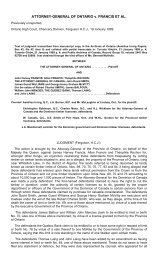ATTORNEY GENERAL for ONTARIO (Respondent) v. BEAR ...
ATTORNEY GENERAL for ONTARIO (Respondent) v. BEAR ...
ATTORNEY GENERAL for ONTARIO (Respondent) v. BEAR ...
Create successful ePaper yourself
Turn your PDF publications into a flip-book with our unique Google optimized e-Paper software.
With respect to the area south of the Height of Land, I find that the land is governed by theRoyal Proclamation of 1763. I find that the intent and effect of that proclamation is to createaboriginal rights that are personal and usufructuary and dependent upon the pleasure of theCrown. The limited dependent nature of these rights is not altered by the fact that theCrown may, as a matter of expediency or goodwill, have chosen to enter into treaties withthe Indians. The relevant date <strong>for</strong> determining aboriginal rights is 1763. With respect to thesmall area north of the Height of Land, I find that the land was not covered by the RoyalProclamation of 1763 but that the rights of the Indians and Crown at common law are in allways the same as in proclamation lands, except that the relevant date <strong>for</strong> determiningaboriginal rights is the coming of settlement.Second, I will deal with the nature of the aboriginal rights exercised in the area south of theHeight of Land in 1763, and in the area north of the Height of Land at the same time, thoughI need not and cannot determine, <strong>for</strong> the latter, the actual time of the coming of settlement. Iconclude that the Royal Proclamation and common law gave to the Indians only theaboriginal right to continue using the lands <strong>for</strong> the purposes and in the manner enjoyed in1763, and not the right to any new uses to which they might subsequently put the land. I listthe traditional uses <strong>for</strong> basic survival and personal ornamentation existing as of 1763.Third, I will deal with the entitlement of the defendants to aboriginal rights in the Land ClaimArea. I find that the defendants have failed to prove that their ancestors were an organizedband level of society in 1763; that, as an organized society, they had exclusive occupation ofthe Land Claim Area in 1763; or that, as an organized society, they continued to exclusivelyoccupy and make aboriginal use of the Land Claim Area from 1763 or the time of the comingof settlement to the date the action was commenced.The appellants and the interveners, including the Attorney General of Canada, all take issue withall or some parts of the trial judge's conclusions on this issue. The appellants do not accept thecritical dates used by the trial judge <strong>for</strong> ascertaining rights or the effect of the Royal Proclamation.It is argued that the trial judge imposed too high a standard of social organization as a prerequisite<strong>for</strong> the acquisition of aboriginal rights. It is further argued that he imposed too high a standard ofexclusive use of the lands in question. Lastly, it is said that he imposed too high an evidentiaryburden on the defendants to prove facts necessary to demonstrate aboriginal rights.In light of the conclusions we have reached with respect to the effect of the Robinson-HuronTreaty, it is not necessary to deal with these arguments. We express no opinion on these issuesand are not to be taken as necessarily approving the views of Steele J. in these matters. We areprepared to assume, without deciding, that the Temagami Indians in 1850 enjoyed aboriginal rightsto at least some part of the Land Claim Area and that these rights extended to the use andoccupation of the lands in the traditional ways of a band.D. Extinguishment of RightsThis court does not feel that it is necessary to deal with every issue put to the trial judge. We aresatisfied that any aboriginal rights enjoyed by the Temagami were extinguished by the Robinson-Huron Treaty of 1850. The Temagami were signatories to the treaty. Alternatively they adhered tothe treaty by receiving annuities pursuant to it and later asking <strong>for</strong> a reserve as was promised in thetreaty and still later receiving a reserve. Finally, their rights were extinguished, even if theTemagami were not signatories or adherents, because the treaty was at least a unilateral act ofextinguishment by the sovereign authority.In support of these conclusions, we are content to rely on the following restricted chronology ofevents which we derive from the findings of the trial judge and our own examination of the evidencethat supports those findings. Because the exhibits and the transcript of evidence use differentterminology <strong>for</strong> Indian bands, names and places, <strong>for</strong> convenience, we have adopted that spellingused by Steele J., even to the point of changing original spellings and names in historicaldocuments.1. Extinguishment by signing the Robinson-Huron Treaty(a)History of the Temagami BandIt is difficult to establish on the evidence when the Temagami Indians became an organized band.There is a reference in the Jesuit Relations of 1640 to an organized band around Lake Temagamicalled the Outemagami, but its authenticity as the original Temagami Band is doubtful. In any



